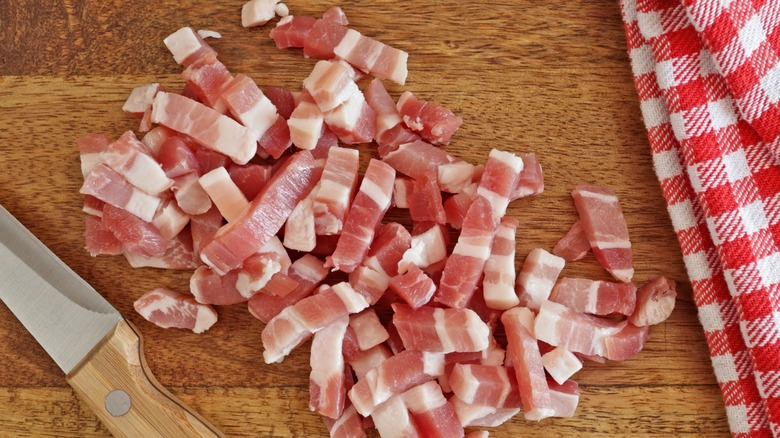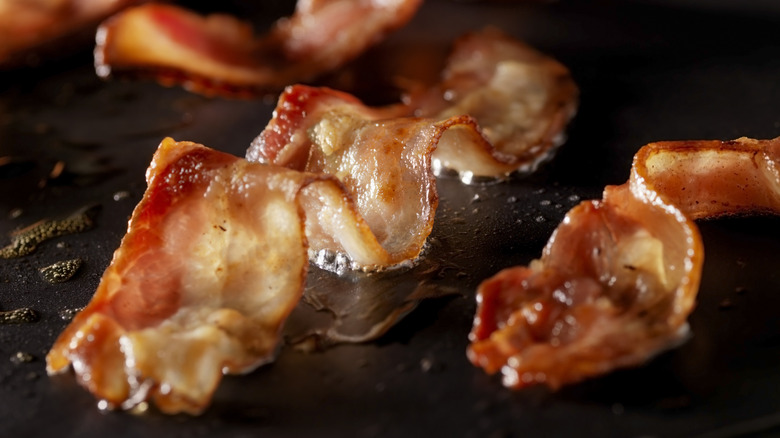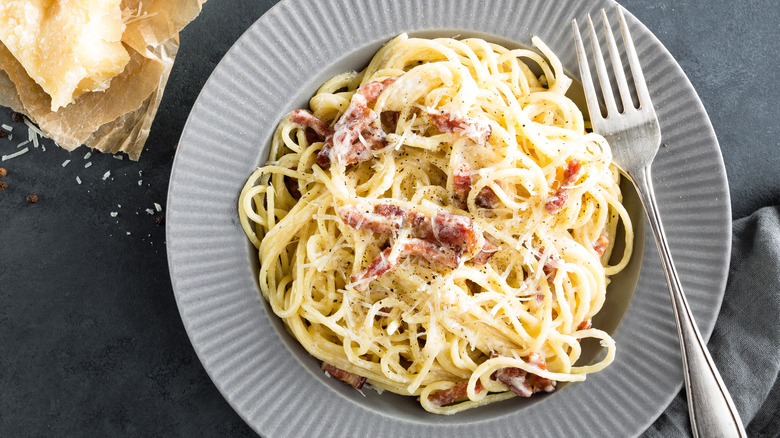The Bite-Sized Difference Between Bacon And Lardon
When people think of bacon, they probably imagine a diner plate of American breakfast, or perhaps a BLT, but it's unlikely they picture bacon's lesser-known relative — lardon. A slab of bacon serves many purposes that go beyond the thin to thick-cut range. One of these purposes is the small bite-sized delicacy of lardon. Bacon and lardon both derive from the bacon slab, yet their differences unlock new flavors and textures that enhance the world of meat garnishes.
The key aspect of lardon is its small rectangular shape which ensures a crispy exterior while maintaining a succulent, meaty interior. This seems comparable to french fries, which, if prepared correctly, are crunchy on the outside and fluffy on the inside. In order to take advantage of this mouthwatering meat, use it as an accessory to omelets and pasta. For example, instead of chopping up bacon, try adding lardon in carbonara. Bacon is equally as versatile as lardon, coming in the forms of breakfast meat, sandwich layers, and wrapping paper for hot dogs.
How to prepare and eat bacon
The perfect strip of bacon might be described with an array of words like crispy, smoky, fatty, salty, and maybe even slightly greasy. Although cooking bacon on the stove is the classic way to go, the oven is a better option since it results in balanced bacon strips. The reason bacon at home curls up is because the meat cooks much quicker than the fat on the stove. However, the perfect piece of bacon will need a bit of fat rendered from it before the meat gets its turn to cook. Sliding the bacon into a 425-degree oven will melt some of the fat faster than on the stove and allow the meat and fat parts to crisp up in unison.
Now that you have your crispy bacon fresh from the oven, a favorite way to eat it this summer is in a BLT sandwich. With thickly cut ripe tomatoes and snappy lettuce, a refreshing BLT is hard to beat for a summer lunch. To take the BLT one level up, add avocado to turn your sandwich into a BLTA.
How to prepare and eat lardon
Unlike pre-cut bacon slices, it's hard to find pre-cut lardon at local grocery stores. But thankfully, it only takes a few extra minutes to chop up a bacon slap into roughly ¼-by-1-inch sticks to make lardon. Be careful not to cut them too small since they shrink while cooking. Lardon should be cooked on the stovetop to render fat and create a crispy exterior while keeping the insides tender and meaty. Again, the french fry effect! Just make sure you monitor the stove so they don't crisp away into dust.
Once the lardon is done cooking, a good tip is to remove any excess grease by patting them lightly with a paper towel. From here, have fun with lardon as a garnish, topping, or pop of flavor and texture. If you want to impress friends with your cooking this summer, elevate your cobb salad by using lardon instead of crumbling up bacon by hand. It adds a different texture while still preserving the crispiness that everyone loves from bacon. Plus, it's way more classy.


